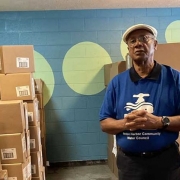When the Water Is Shut Off
Cities employ vastly different strategies for late-paying customers.

By Brett Walton, Circle of Blue
At the beginning of May last year, some 40,000 households in Philadelphia were at least $75 and two months behind on their water bills, making them vulnerable to action by the city Water Department to shut off their water.
The department does not play around with overdue water customers. It uses past-due balance and the billing cycle to determine residential accounts eligible for water shut-offs and issues a warning printed on their water bills.
If the late-payers ignore those warnings the department issues two more with unmistakable guidance: Set up a payment plan or water will be turned off. If payment is not made after that, the department has the authority to close the valve that connects the main pipe to the house, and lock the meter box if there are signs of tampering.
Though the warning protocol is clear, there is wiggle room in the shutoff process. Not everyone will have water turned off immediately. With about nine percent of residences exceeding the thresholds at any given time, the 30 people on the water department’s shut-off crew cannot shut off households at the moment they become eligible.
Instead, the crew is discerning, explained Joanne Dahme, the department’s spokeswoman. Workers on the shut-off crew look at the worst offenders — typically households that owe thousands of dollars. Using those homes as a hub, the crew fans outward, turning off water to late-payers nearby, regardless of the size of the debt. Using this clustering method, which the department selected for its efficient use of work time, the crew can process roughly 3,000 shutoffs per month, Dahme told Circle of Blue.
Naturally, not all residents are pleased with the system.
“We hear it from customers, ‘But I’m only $200 behind, why’d you shut me off?’” Dahme recounted during an interview in the water department offices. She then used a fishing metaphor to describe the outcome. “We sweep up a lot of little fish in that net.”
All utilities, to varying degrees, shut off water service to households who do not pay bills. Shutoffs, utilities argue, are an essential tool for maintaining financial health. They are the leverage that ensures payment. The universe of U.S. water utilities is vast and varied. There are more than 50,000 systems that serve 15 or more people year-round. Circle of Blue requested shutoff data from eleven of the country’s largest water utilities and conducted in-depth interviews with staff on shutoff policies and practices. Policies on the third stage of shutoffs — how utilities select which accounts to turn off — are rarely publicized.
Delivering water, utility officials point out, costs money, and customers need to pay for the service to keep the system operating. “All costs are paid by existing customers,” Sean Hennessy, chief financial officer for Kansas City Water, told Circle of Blue. “If one customer doesn’t pay, another customer has to pay more. That cost potentially makes it harder for them. You can get into a vicious cycle.”
As water rates climb higher to pay for years of deferred maintenance, new regulatory requirements, and system upgrades, utilities have come under pressure for their shutoff policies. Activists in the financially beleaguered cities of Baltimore and Detroit, in recent years, called for a moratorium on shutoffs, pointing out billing errors and the risk of disease if shutoffs are concentrated within neighborhoods. They argue that utilities can be more attentive in designing affordable rates that prevent households from falling behind.
Shutoff criteria are typically posted on a utility’s website and in its bylaws. The criteria state the level of debt and tardiness a utility will tolerate. Though all utilities shut off water to late-paying customers, their methods — from eligibility requirements and choosing which accounts to shut off, to the cost of turning water back on — are unique. Whether strict or lenient, interactive with residents or aloof, how utilities manage shutoffs influences customer behavior — and affects the chances of getting a timely payment.
When to Shut Off Service
Not every shutoff is due to a household not being able to afford water. Some shutoffs occur because a house was abandoned or the owners simply forgot to pay. But affordability is the topic that dominates the shutoff debate.
Utilities begin the shutoff process by setting criteria for when to disconnect customers. Like Philadelphia, all the utilities interviewed for this story used a combination of past-due balance and number of days late to determine the households that are eligible for a shutoff. For Seattle Public Utilities the thresholds are $300 past due and 52 days. For Phoenix Water: $75 and 30 days. For Denver Water: $125 and 50 days.
Exceeding the shutoff criteria is only the first step in the shutoff process. Most utilities attempt to contact customers and warn them of the action about to be taken. Philadelphia requires two written notices after a household is eligible for shutoff before the utility can stop service. Staff from the San Francisco Public Utilities Commission contact late-payers for more context: was there a medical emergency or job loss? San Antonio Water System sends automated phone calls to homes when a payment is late. If a household contacts the department the shutoff is put on hold for four to six weeks while a payment plan is worked out.
When to collect? Which households to target? How lenient should shutoff policies be? These are questions that utility officials ask themselves, all in the goal of getting payment for service while being compassionate towards customers who find themselves in financial distress.
Utilities diverge sharply when it comes to turning the valve to shut off service. They employ a number of strategies for doing the work.
Seattle Public Utilities, for instance, divides the city into quadrants and focuses its shutoff procedures on the highest and oldest past-due balances in each quadrant. The rotations are so that one area of the city is not disproportionately targeted. “Performing shutoffs by separate quadrants helps ensure a measure of geographical equity,” said Andy Ryan, Seattle Public Utilities spokesman.
San Antonio Water System also uses rotations. Its workers move clockwise around the city by zones, concentrating their efforts for shutoffs, pipe repairs, meter checks, and other tasks in one zone per day.
In Phoenix, shutoffs occur based on the location of the work crew and the number of days since last payment.
In Kansas City, meanwhile, the department uses an approach that, at first, seems counterintuitive. Staff look at which accounts are $150 and 60 days overdue. They then focus on how many days have passed since the last payment. An account whose last payment was three months ago is more likely to be targeted than one that is six months overdue, regardless of the past-due balance, Hennessy said. That’s because in Kansas City, many renters have the water bill in their names. The more recent the last payment, the more likely that person is still living at the house and the department will be able to collect. “Timeliness in the shutoff is key to getting payment,” Hennessy said.
Some officials wonder whether doing shutoffs sooner is helpful for customers because it prevents a small debt from ballooning into insurmountable hurdle. “There’s something to be said about doing a shutoff before the balances become overwhelming,” reasoned Kathryn Sorensen, director of the Phoenix Water Department. In that case, a utility might do more shutoffs, she told Circle of Blue.
“If you get turned off after 10 days late, it’s going to encourage you to stay on top of your bill,” Emi Hogue, a customer service analyst for the San Antonio Water System, told Circle of Blue.
Ten days would be a remarkably rapid turn-around, perhaps unfair. None of the utilities that Circle of Blue contacted turned water off that quickly.
Little research exists on the relationship between utility shutoff policies and customer behavior. Several researchers told Circle of Blue that scarce publicly available data on shutoffs leads to gaps in understanding. Data from Seattle supports the view that shutoffs do encourage timely payment.
In 2016, Seattle Public Utilities introduced a new billing system. During the early months of the new system, SPU decided to suspend shutoffs so that it could ensure that there were no billing errors during the transition between systems. Between August 2016 and February 2017, the utility did not shut off any accounts, even if customers were late. It did not announce this policy publicly.
Even so, there was a marked effect on bill payment. Debt for accounts that were 91 days past due more than doubled when shutoffs were suspended, from $1.54 million on August 31, 2016, to $5.03 million by January 1, 2017. At the end of October 2017, nine months after shutoffs had been reinstated, past-due debt had dropped to $2.61 million.
“Those utilities that exercise shutoffs have more management of outstanding debt,” Susan Sanchez, Seattle Public Utilities’ deputy director of customer service, told Circle of Blue.
Customer assistance programs, another remedy, also seem to help utilities manage outstanding customer debt — by preventing it from accruing to begin with.
Again, no database exists for a large-scale analysis, but a few data points stand out. For households enrolled in Seattle’s utility discount program, less than one-half of one percent — 133 out of 30,143 — had water shut off in 2016 because of late payment. In San Francisco, only one household in the assistance program had water turned off in 2017. (The number of people enrolled in assistance programs, however, is usually far lower than the number of people eligible, which is why advocates lobby for simpler application and enrollment procedures.)
The Philadelphia Water Department hopes that its new aid program will work similar wonders, Michelle Bethel, the deputy commissioner in charge of the Water Revenue Bureau, told Circle of Blue.
Last July the department established a water rate for poor households that is based on their income. For those enrolled in the program monthly water bills are a fixed percentage of their wages. Income-based rates are a tactic common in the electric power industry, but not for water utilities.
“We’re hoping that with affordable bills we don’t have to have shutoffs,” Bethel said.
This story has been updated since first publication with revised numbers on utility discount program shutoffs from Seattle Public Utilities.
Brett writes about agriculture, energy, infrastructure, and the politics and economics of water in the United States. He also writes the Federal Water Tap, Circle of Blue’s weekly digest of U.S. government water news. He is the winner of two Society of Environmental Journalists reporting awards, one of the top honors in American environmental journalism: first place for explanatory reporting for a series on septic system pollution in the United States(2016) and third place for beat reporting in a small market (2014). He received the Sierra Club’s Distinguished Service Award in 2018. Brett lives in Seattle, where he hikes the mountains and bakes pies. Contact Brett Walton









